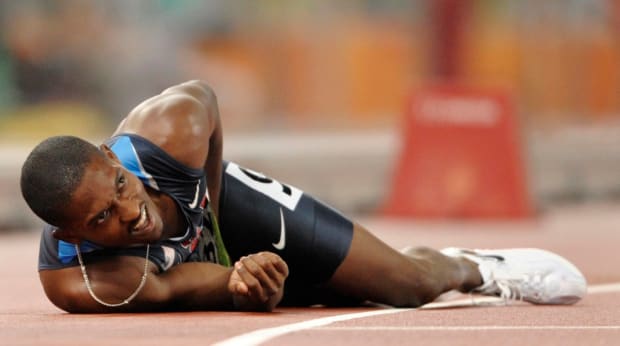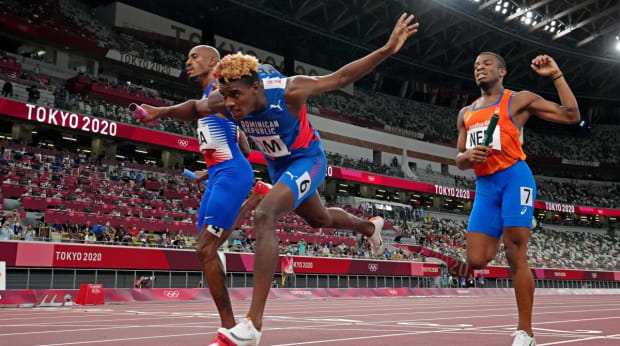Sprinter David Neville is known for his leap for bronze in the 2008 Games. Were the cuts and bruises that he and other runners have endured worth it?
Sign up for our free daily Olympics newsletter: Very Olympic Today. You'll catch up on the top stories, smaller events, things you may have missed while you were sleeping and links to the best writing from SI’s reporters on the ground in Tokyo.
TOKYO – The American sprinter David Neville does not mention his dive often. But even now, 13 years later, it still comes up. There’s proof, an image that will live forever on the Internet: Of a finish line, in the 2008 Olympics, with runners standing upright or leaning forward. That same image also features Neville, his feet off the ground, body almost vertical, arms extended to break his fall.
He’s still not exactly sure how he ended up there, floating across the finish line, completing a maneuver among the most daring, most visceral—and possibly most foolish—in track and field. Now an assistant coach for the Tennessee track team, his sprinters sometimes come across that snapshot, or someone sends them a video of Neville looking like Pete Rose sliding into home. “Oh, you’re that guy,” they’ll say. “The guy who dived across the line.”
As one of the fastest and most chaotic Olympic track and field competitions ever sprints to its conclusion here in Tokyo, four days of events leave plenty of time for another indelible moment in sprinters diving over finish lines. The split second when track meets swimming and desperation causes athletes who win with their feet to leave the ground entirely.

Neville still remembers most details of his race, the 400-meter final in Beijing. The first half was more of a blur, but when he turned the second corner, with about 150 meters remaining, he realized he had a chance to medal, the goal he had set before the competition started. He had inside position, and he hadn’t seen another competitor by then, which is generally a good sign.
On the final homestretch, he chugged toward the finish with two other Americans, Jeremy Wariner and LaShawn Merritt. But Neville’s legs started to feel heavy, which is generally not a good sign. “I lost some steam,” he says. He pushed through the final 15 meters anyway, as hard as he could, and right at the end, he leaned forward, also as hard as he could. Ultimately, he leaned too far forward, which upended his body, as he dove over and skidded across the track.
Here’s the thing about diving in a sprint rather than into a pool: it hurts, a lot. For Neville, at least, it had rained before the race, allowing him to slide more than someone usually would. Still, when he showered later, burns covered his midsection, thighs and parts of his arms and shoulders. This wasn’t a basketball player covered in sweat sliding across slick hardwood with relative ease. This was a carpet burn. But from a track.
Neville’s dive fell into the usual category, in that it was unintentional, the byproduct of desperation mixed with instinct mixed with whoops. It wasn’t unlike what happened in the mixed race here in Tokyo for the 4X400-meter relay. Alexander Ogando of the Dominican Republic also bent forward at the finish, toppling over, as if he had tripped. In both instances, the maneuver worked. Neville won the bronze he stores in a safe-deposit box; Ogando’s relay team, because of his dive-adjacent stumble, nabbed the silver. Both men essentially left their feet because their bodies told them to, as nature’s way to brake.

For Neville and most of the track divers, those moments speak to something larger: The magnitude of the Olympic Games. They toil for four years, mostly in obscurity, training and training to training to compete in a handful of races; sometimes, in only one event. They tell themselves that they will sacrifice everything, do anything, to win a medal. The 400 meters is a particularly brutal endeavor, a full sprint around a track. Neville arrived at the exact scenario, through a million tiny dots that connected at just the right pace, at just the right moment, where his do-anything ethos would be tested. Really, anything? He answered. Yes.
Ralph Reiff is a performance coach who works for Butler. He understands the science behind the sprints. He also asks runners why they dive, because it fascinates him, not the leaps themselves but the motivation behind them. Most say the same as Neville, that they dove because they had to, because they didn’t feel like they had another choice. They’re taught to accelerate through the finish line, to not lose speed. But these are not Formula One races, with signs on the side alerting competitors to slow down. It’s not easy—really, it’s almost impossible—to remember anything at the end of a 400. Like even one’s name.
The athletes who say these things to Reiff all saw the best dive in track history. It came, fittingly, from a hurdler named Infinite Tucker, who ran for Texas A&M. Neville was there that day, in May of 2019, for the SEC Championship meet. Tucker competed in the 400, only the hurdle version, and also approached the finish line in a dead heat. But rather than lean and dive, he just … dove, like Superman had taken over his body. Tucker won, the video went viral, ESPN nominated the moment for an ESPY, and a man named Infinite had shown the world just what was possible when a runner left their feet.
Al Joyner spent his whole life in track, first as a triple jump gold medalist (1984), then and now as a coach. His late wife Florence Griffith Joyner ranks among the best sprinters of all time. His sister, Jackie Joyner-Kersee, still holds myriad heptathlon and triple jump records. All of which is to say that Joyner understands the track dive more than most. He uses an odd-yet-fitting analogy to describe what happens. It’s like reaching the final part of the ice cream before the cone, he says, only the ice cream itself is melting rapidly, so the eater in the scenario shoves the rest into their mouth. It’s not, oh, I must grab this cone, lift it to my face and finish the six bites that are left in one. It’s more primal than that. It’s, oh, no, time to eat.
Even then, when the mindset involved is understandable, it’s still unadvisable to launch. Neville said his famous maneuver has never once come up in his coaching career, while numerous studies show that runners who leave their feet—like shortstops who slide into home—actually slow their momentum. Bill Nye The Science Guy has addressed this on Twitter, the science involved, noting more or less physics. ESPN’s Sports Science division studied the same for a feature, finding that at the start of a dive, the runners decelerated, losing speed. They would have been better off finishing in a short burst.
There’s probably an undetermined sweet spot in there somewhere, according to those who study such things, where a dive, timed right, yields a better result. But no one has identified that spot, and even if they did, imagine trying to make that decision running as fast as sprinters run. “It’s more of a flight-or-fight thing,” Reiff says, “which is part of what makes the Olympics great, how much it means, the high risk.”
Sometimes, the dives work, though. Neville won bronze by 0.04 seconds. Tucker won first by 0.09. And in the 2016 Games, Shaunae Miller-Uibo of the Bahamas edged Allyson Felix in the 400-meter sprint by 0.41 seconds. Miller-Uibo triumphed because she left her feet, right in that sweet spot, apparently. Had she remained upright, most experts believe she would have lost. Now, she has the gold medal to prove that diving occasionally nets the ideal finish.
“I’ve never done it before,” she told reporters. “I have cuts and bruises, a few burns. It hurts.”
This moment sparked a mild controversy, where something only few in the world have actually read was disseminated widely: The Olympic track and field rulebook. On this matter, the rules are clear. The first sprinter/hurdler/runner whose torso crosses the vertical plane of the closest edge of the finish line wins. In this case, the torso is defined as not the “head, neck, arms, legs, hands or feet.”
As Olympic track and field continued Thursday, there was desperation at the finish line, athletes who trained for five years this cycle and the goals they ran toward. That few of them tried a dive spoke to the science, the inherent risk and track burns, rather than carpet ones. Neville, though, will always have his moment—and the medal it made possible.
More Olympics Coverage:
• An Underdog Emerges From an Underachieving Olympics Nation
• Sakura Kokumai’s All-Consuming Odyssey to Karate’s Olympic Debut
• Star Sydney McLaughlin Captains U.S. Track and Field's Youth Movement
• Noah Lyles's Bronze Medal Win a Poignant Moment in His Olympic Journey